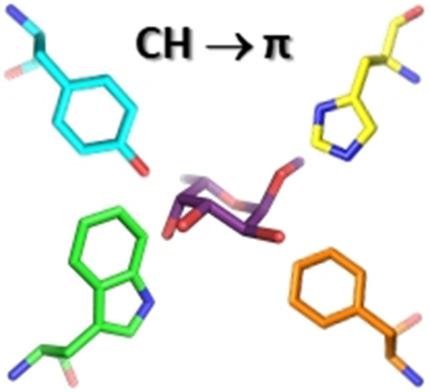当前位置:
X-MOL 学术
›
Chem. Eur. J.
›
论文详情
Our official English website, www.x-mol.net, welcomes your feedback! (Note: you will need to create a separate account there.)
The CH-π Interaction in Protein-Carbohydrate Binding: Bioinformatics and In Vitro Quantification.
Chemistry - A European Journal ( IF 4.3 ) Pub Date : 2020-03-24 , DOI: 10.1002/chem.202000593 Josef Houser 1, 2 , Stanislav Kozmon 1, 3 , Deepti Mishra 1 , Zuzana Hammerová 2 , Michaela Wimmerová 1, 2, 4 , Jaroslav Koča 1, 2
Chemistry - A European Journal ( IF 4.3 ) Pub Date : 2020-03-24 , DOI: 10.1002/chem.202000593 Josef Houser 1, 2 , Stanislav Kozmon 1, 3 , Deepti Mishra 1 , Zuzana Hammerová 2 , Michaela Wimmerová 1, 2, 4 , Jaroslav Koča 1, 2
Affiliation

|
The molecular recognition of carbohydrates by proteins plays a key role in many biological processes including immune response, pathogen entry into a cell, and cell–cell adhesion (e.g., in cancer metastasis). Carbohydrates interact with proteins mainly through hydrogen bonding, metal‐ion‐mediated interaction, and non‐polar dispersion interactions. The role of dispersion‐driven CH–π interactions (stacking) in protein–carbohydrate recognition has been underestimated for a long time considering the polar interactions to be the main forces for saccharide interactions. However, over the last few years it turns out that non‐polar interactions are equally important. In this study, we analyzed the CH–π interactions employing bioinformatics (data mining, structural analysis), several experimental (isothermal titration calorimetry (ITC), X‐ray crystallography), and computational techniques. The Protein Data Bank (PDB) has been used as a source of structural data. The PDB contains over 12 000 protein complexes with carbohydrates. Stacking interactions are very frequently present in such complexes (about 39 % of identified structures). The calculations and the ITC measurement results suggest that the CH–π stacking contribution to the overall binding energy ranges from 4 up to 8 kcal mol−1. All the results show that the stacking CH–π interactions in protein–carbohydrate complexes can be considered to be a driving force of the binding in such complexes.
中文翻译:

蛋白-碳水化合物结合中的CH-π相互作用:生物信息学和体外定量。
蛋白质对碳水化合物的分子识别在许多生物过程中都起着关键作用,包括免疫应答,病原体进入细胞以及细胞间粘附(例如,在癌症转移中)。碳水化合物主要通过氢键,金属离子介导的相互作用和非极性分散相互作用与蛋白质相互作用。长期以来,由于极性相互作用是糖类相互作用的主要推动力,因此低估了分散驱动的CH-π相互作用(堆积)在蛋白质-碳水化合物识别中的作用。然而,在过去的几年中,事实证明,非极性相互作用同样重要。在这项研究中,我们使用生物信息学(数据挖掘,结构分析),一些实验性(等温滴定热量法(ITC),X射线晶体学)和计算技术。蛋白质数据库(PDB)已用作结构数据的来源。PDB包含超过12000种蛋白质复合物和碳水化合物。此类复合物中经常出现堆积相互作用(约占已鉴定结构的39%)。计算和ITC测量结果表明,CH–π堆积对总结合能的贡献范围为4至8 kcal mol。-1。所有结果表明,蛋白质-碳水化合物复合物中堆积的CH-π相互作用可被认为是此类复合物中结合的驱动力。
更新日期:2020-03-24
中文翻译:

蛋白-碳水化合物结合中的CH-π相互作用:生物信息学和体外定量。
蛋白质对碳水化合物的分子识别在许多生物过程中都起着关键作用,包括免疫应答,病原体进入细胞以及细胞间粘附(例如,在癌症转移中)。碳水化合物主要通过氢键,金属离子介导的相互作用和非极性分散相互作用与蛋白质相互作用。长期以来,由于极性相互作用是糖类相互作用的主要推动力,因此低估了分散驱动的CH-π相互作用(堆积)在蛋白质-碳水化合物识别中的作用。然而,在过去的几年中,事实证明,非极性相互作用同样重要。在这项研究中,我们使用生物信息学(数据挖掘,结构分析),一些实验性(等温滴定热量法(ITC),X射线晶体学)和计算技术。蛋白质数据库(PDB)已用作结构数据的来源。PDB包含超过12000种蛋白质复合物和碳水化合物。此类复合物中经常出现堆积相互作用(约占已鉴定结构的39%)。计算和ITC测量结果表明,CH–π堆积对总结合能的贡献范围为4至8 kcal mol。-1。所有结果表明,蛋白质-碳水化合物复合物中堆积的CH-π相互作用可被认为是此类复合物中结合的驱动力。



























 京公网安备 11010802027423号
京公网安备 11010802027423号